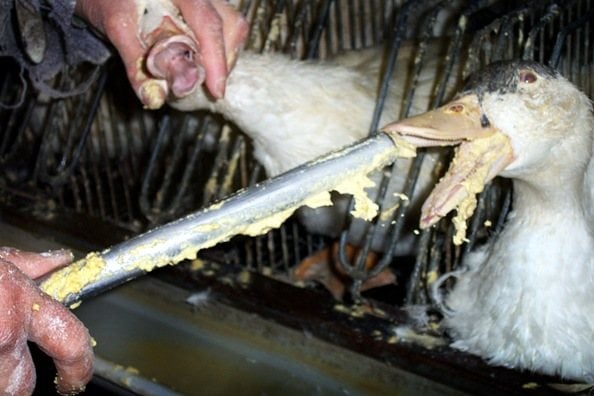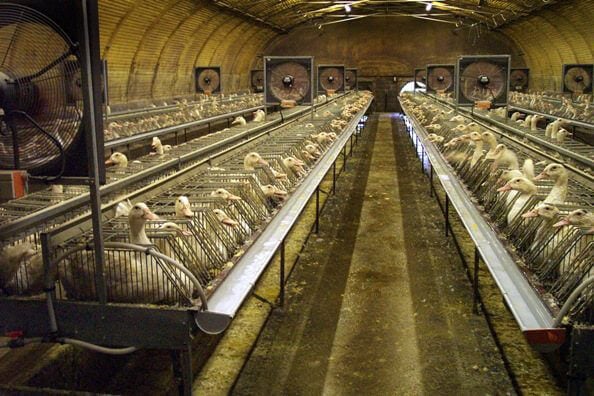Top 5 Reasons to Ban Foie Gras Nationwide
With California’s foie gras ban having taken effect July 1, it’s time for the rest of the country to do some soul-searching, starting with New York, the only state in the union with operating foie gras farms. Here are the top five reasons for the rest of the country to follow California’s lead in banning this dreadful “delicacy”:

(c)stopgavage.com
1. Gavage Is Savage
Birds raised for foie gras are force-fed multiple pounds of grain and fat every day via a pneumatic tube that is rammed down their throats—a process that former California Sen. John Burton colorfully describes as “doing the equivalent of waterboarding.” Burton, who spearheaded California’s ban, has said of chefs opposing the ban: “I’d like to sit … them down and have duck and goose fat—better yet, dry oatmeal—shoved down their throats over and over and over again.”
2. Foie Gras Is Sick—Literally
Force-feeding causes birds’ livers to swell to as much as 10 times their normal size, resulting in a painful disease known as hepatic steatosis (which makes foie gras a diseased organ and therefore illegal to sell in the U.S., according to a lawsuit filed last month by several animal protection groups). The birds often suffer from internal hemorrhaging, fungal and bacterial infections, and hepatic encephalopathy, a brain disease caused when their livers fail.
3. Foie Gras Makes Me—and Ducks—Gag
Contrary to the claims of foie gras peddlers, ducks do have a gag reflex, and, in fact, often vomit after being force-fed. An employee at California’s now-defunct foie gras farm admitted that “[s]ome [ducks] die from heart failure as a result of the feeding, or from choking when they regurgitate.” An undercover investigator at a Canadian foie gras farm saw a duck vomiting blood after the force-feeding pipe apparently punctured his esophagus or stomach.
4. Ducks Aren’t Shoes
Undercover video shot on French farms, which supply much of the foie gras sold worldwide, shows ducks crammed individually into shoebox-like cages that are barely larger than the birds’ bodies. Their heads and necks protrude through a small opening for force-feeding. The ducks are confined in this way—unable even to stretch a wing or take a single step in any direction—for 24 hours a day. Many don’t survive the ordeal: An average of 20 percent of ducks on foie gras farms die before slaughter. That’s 10 to 20 times the average death rate on a regular duck farm.
5. Everybody Else Is Doing It
Force-feeding birds has been denounced worldwide by experts in the field of poultry welfare. The scientific consensus is so strong that foie gras production has been banned in more than a dozen countries, including the U.K., Israel, Germany, Norway, Poland, Sweden, and Switzerland, and it will be outlawed throughout the European Union by 2020. Prince Charles refuses to allow foie gras on Royal menus, and celebrity chef Wolfgang Puck refuses to serve it.
(c)stopgavage.com

(c)stopgavage.com
While we wait for the rest of the country to follow California’s progressive lead, you can help ducks right now by urging the gourmet grocery chain Dean and DeLuca to stop selling foie gras.

